
Home
Mission
Overview of Project
Project Staff
Sponsors
Achievements
Checking, Illustrations
Upcoming Activities
Id and Species Lists
Protea Information
Protea Gallery
Growing Proteas
Interim Dist. Maps
Publications
Afrikaanse Inligting
![]()
Elongate Sceptres - Paranomus
Hairy-styled Sceptre - Paranomus adiantifolius
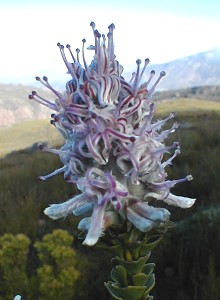 |
Habit: An erect sparsely
branched shrub up to 1.7m tall Fire survival: Killed, only seeds survive Sexual system: Both sexes in each flower Flowers: September - November Pollinator: Insects Fruit: Released 2 months after flowering Seed dispersal: Ants Seed storage: Underground in ants nests Rarity status: Rare Habitat: Sandstone sands, 500-1000m Distribution: Wolfieskop in Riviersonderend Mountains, Houhoek and Groenlandberg Mountains |
Van Staden's Sceptre - Paranomus reflexus
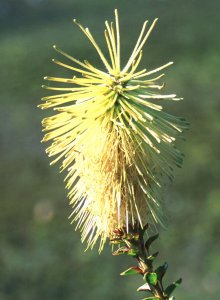 |
Habit: A branched shrub up
to 1.5m tall Fire survival: Killed, only seeds survive Sexual system: Both sexes in each flower Flowers: June - August Pollinator: Insects Fruit: Released 2 months after flowering Seed dispersal: Ants Seed storage: Underground in ants nests Rarity status: Rare, typically in small clumps of a few dozen plants Habitat: Sandstone sands, 1000-2000m Distribution: Elandsberg and Van Stadensberg |
Honey-Scented Sceptre - Paranomus roodebergensis
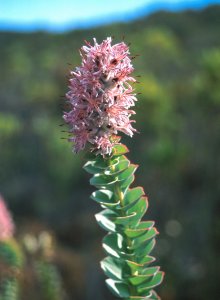 |
Habit: A branched shrub up
to 2.5m tall Fire survival: Killed, only seeds survive Sexual system: Both sexes in each flower Flowers: August - October Pollinator: Insects Fruit: Released 2 months after flowering Seed dispersal: Ants Seed storage: Underground in ants nests Rarity status: Rare, but locally abundant on Rooiberg Habitat: Sandstone sands, 600-1300m Distribution: Rooiberg, Huis River Pass and Touwsberg |
King Gustaf's Sceptre - Paranomus sceptrum-gustavianus
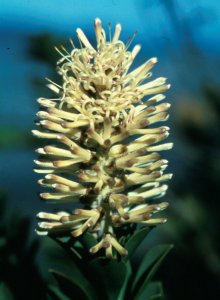 |
Habit: A branched shrub up
to 1.8m tall Fire survival: Killed, only seeds survive Sexual system: Both sexes in each flower Flowers: July - March Pollinator: Insects Fruit: Released 2 months after flowering Seed dispersal: Ants Seed storage: Underground in ants nests Rarity status: Rare, solitary plants or isolated clumps occur Habitat: Sandstone slopes, 150-500m Distribution: Hottentots-Holland Mountains to Western Langeberg and to the Elim Flats |
Langeberg Sceptre - Paranomus spathulatus
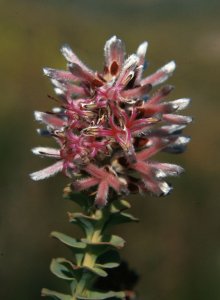 |
Habit: A branched shrub up
to 2.5m tall Fire survival: Two strategies known. Some populations killed by fire. Others resprout from an underground bole Sexual system: Both sexes in each flower Flowers: May - December Pollinator: Insects Fruit: Released 2 months after flowering Seed dispersal: Ants Seed storage: Underground in ants nests Rarity status: Rare, abundant in sparse, isolated populations Habitat: Sandstone sands, 300-600m Distribution: Langeberg from Tradouw Pass to Garcia's Pass |
Gamka Sceptre - Paranomus spathulatus "gamkaensis"- found in the Gamka Mountains
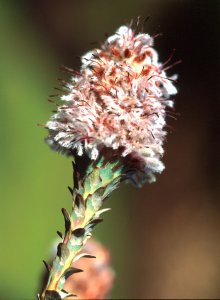 |
Habit: A branched shrub up
to 2.5m tall Fire survival: Two strategies known. Some populations killed by fire. Others resprout from an underground bole Sexual system: Both sexes in each flower Flowers: May - December Pollinator: Insects Fruit: Released 2 months after flowering Seed dispersal: Ants Seed storage: Underground in ants nests Rarity status: Rare, abundant in sparse, isolated populations Habitat: Sandstone sands, 300-600m Distribution: Only known from Gamka Nature Reserve and adjacent farms |
Back Sceptre Gallery